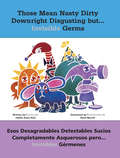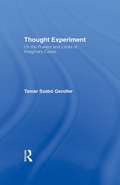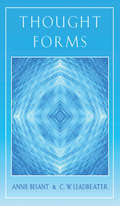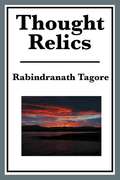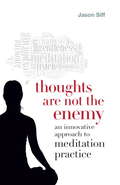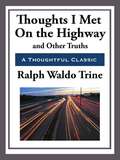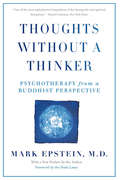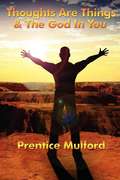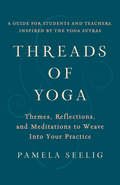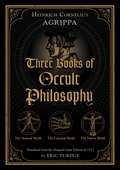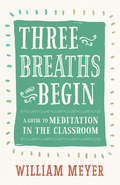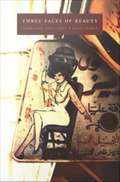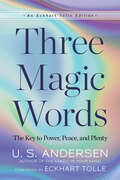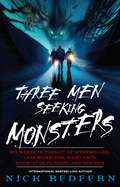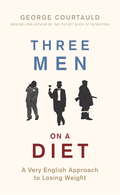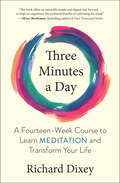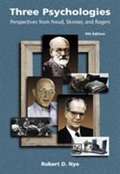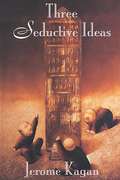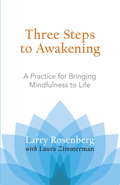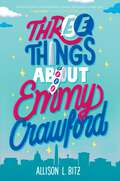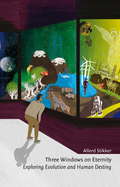- Table View
- List View
Those Mean Nasty Dirty Downright Disgusting but...Invisible Germs: Esos desagradables detestables sucios completamente asquerosos pero . . . invisibles gérmenes
by Judith Anne Rice Reed MerrillEncourage the formation of good health habits in children. Through playful and colorful illustrations, this popular children's book shows the germs that cause illness and how important hand washing is to good health. Includes health information
Thought Experiment: On the Powers and Limits of Imaginary Cases
by Tamar Szabo GendlerThis book offers a novel analysis of the widely-used but ill-understood technique of thought experiment. The author argues that the powers and limits of this methodology can be traced to the fact that when the contemplation of an imaginary scenario brings us to new knowledge, it does so by forcing us to make sense of exceptional cases.
Thought Forms
by Annie BesantWhat do ideas look like? This clairvoyant view of the shape, color, and atmospheric effect of mental energy includes black-and-white drawings and color plates to convey a graphic representation of the power of thought.
Thought Relics
by Rabindranath TagoreIt is given to us to reveal our soul, that which is One in us, which is eternal. This can only be done by its passage through the fleeting Many; to assert the infinity of the spirit by continual sacrifice of forms. The self being the vessel that gathers and holds gives us the opportunity of giving up. If we believe only in self then we anxiously cling to our stores which causes us misery and failure. When we believe in soul the very inconstancy of life finds its eternal meaning and we feel that we can afford to lose
Thoughts Are Not the Enemy
by Jason SiffA revolutionary new approach to meditation: a mindfulness of thinking that accepts and investigates the thoughts that arise as you meditate--from the author of Unlearning Meditation. In most forms of meditation, the meditator is instructed to let go of thoughts as they arise. As a result, thinking is often taken, unnecessarily, to be something misguided or evil. This approach is misguided, says Jason Siff. In fact, if we allow thoughts to arise and become mindful of the thoughts themselves, we gain tranquillity and insight just as in other methods without having to reject our natural mental processes. And by observing the thoughts themselves with mindfulness and curiosity, we can learn a good deal about ourselves in the process.
Thoughts I Met on the Highway and Other Truths
by Ralph Waldo TrineRalph Waldo Trine was an important New Thought writer. Trine is often cited as the inspiration for Napoleon Hill's Think and Grow Rich. As with all New Thought writers, Trine's work helped to shape the current crop of self-help books, such as The Secret, The Power of Positive Thinking, and The Law of Attraction. Also in this edition: A Creed of the Open Road, and The Greatest Thing Ever Known. The wisdom of the ages can be found between these pages!
Thoughts Without A Thinker: Psychotherapy from a Buddhist Perspective
by Mark EpsteinThe line between psychology and spirituality has blurred, as clinicians, their patients, and religious seekers explore new perspectives on the self. A landmark contribution to the field of psychoanalysis, Thoughts Without a Thinker describes the unique psychological contributions offered by the teachings of Buddhism. Drawing upon his own experiences as a psychotherapist and meditator, New York-based psychiatrist Mark Epstein lays out the path to meditation-inspired healing, and offers a revolutionary new understanding of what constitutes a healthy emotional life.
Thoughts are Things & God In You
by Prentice MulfordPrentice Mulford was one of the leaders of the New Thought Movement. These are two of his most important essays. In them you will find out how to use the power of your thoughts to improve your life and to bring yourself closer in tune with the essence of god and the universe. His writing is simple yet profound. Unlock your inner god and find a peace of mind you've always wished for.
Thoughts without a Thinker
by Mark EpsteinThoughts Without a Thinker is the landmark book that brought the worlds of Buddhism and psychotherapy into contact with each other, and changed thousands of lives. Drawing upon his own experience as therapist, meditator, and patient, Mark Epstein, a New York-based psychiatrist trained in classical Freudian methods, integrates Western psychotherapy and the teachings of Buddhism. In accessible, intimate language, this enlightening guide explains the unique psychological contributions of the teachings of Buddhism, describes the path of meditation in contemporary psychological language, and lays out the possibility of a meditation-inspired psychotherapy. Mark Epstein's new introduction reflects on the impact of the book and on the evolving relationship between psychotherapy and Buddhism.
Threads of Yoga: Themes, Reflections, and Meditations to Weave into Your Practice
by Pamela SeeligDeepen and enliven your yoga practice with 30 themes based on Patanjali&’s Yoga Sutras that can inspire on and off the mat.Yoga draws many practitioners because of its physical benefits, but it is often the experience of peace that people return for. Threads of Yoga supports those seeking to learn more about yoga&’s deeper spiritual teachings. Each short chapter introduces a foundational yogic theme, such as letting go, the breath, the yamas and the niyamas, and the chakra system. Each theme is accompanied by practices, including meditation, complementary poses, breath work, or quotes to contemplate. It is an ideal guide for both practitioners and teachers who want to connect with the spiritual wisdom of yoga, deepen their personal practice, or develop and support a theme for yoga class.
Three Books of Occult Philosophy
by Heinrich Cornelius Agrippa• Three hardcover volumes in slipcase • Corrects the many mistranslations, copyist mistakes, and errors introduced from other editions, drawing on new research and access to Agrippa&’s source texts • Restores all of Agrippa&’s original illustrations • Presents a nearly complete bibliography of Agrippa&’s primary sources One of the most important texts in the Western magical tradition for nearly 500 years, Heinrich Cornelius Agrippa&’s 1533 work Three Books of Occult Philosophy collates a multitude of sources from the Classical, Medieval, and Renaissance periods and organizes them into a coherent explanation of the magical world. Divided into three parts--the natural world, the celestial world, and the divine world--the book systematically explains the philosophy, logic, and methods of magic and astrology and how they work. The basis for 19th-century magical orders such as the Golden Dawn and a primary source for countless books on magical uses of stones, herbs, incense, and astrology, Agrippa&’s many lists and diagrams have proven invaluable to magicians since the 16th century. Yet, until now, all English editions of Agrippa&’s Three Books were based on the same flawed 1651 translation from the mysterious &“J.F.&” In this new translation from the original 1533 Latin edition, Eric Purdue corrects the many mistranslations, copyist mistakes, and errors introduced from other editions as well as restores all of Agrippa&’s original illustrations. Purdue notates every correction and offers commentary, drawing on major developments in the research of older magical and astrological texts. He also presents a nearly complete bibliography of Agrippa&’s primary sources, revealing Agrippa as a mainstream scholar of his day. Presenting the first new English translation of Three Books of Occult Philosophy in more than 350 years, this three-volume hardcover boxed set repairs the gaps in knowledge pervasive in the original translation and restores the magical spirit of Agrippa&’s masterpiece, allowing us to hear Agrippa speak again.
Three Breaths and Begin: A Guide to Meditation in the Classroom
by William MeyerLEARN THE TRANSFORMATIVE POWER OF MEDITATION IN THE CLASSROOM Meditation can be a potent practice for creating focus and facilitating learning in the classroom, for kindergarteners, grad students, and everyone in between. Longtime schoolteacher William Meyer has taught a variety of meditation techniques to students, fellow teachers, and parents with remarkable results. In Three Breaths and Begin, Meyer details how teachers can incorporate mindfulness into their curricula every day. He covers every aspect of teaching meditation, from creating a dedicated space in the classroom to meditating on field trips, in sports settings, and even in the midst of tragedy. Offering numerous ready-to-use scripted meditations, this insightful, practical, and loving guide will benefit anyone interested in the well-being of students — and, most of all, the students themselves.
Three Faces of Beauty: Casablanca, Paris, Cairo
by Susan OssmanThree Faces of Beauty offers a unique approach to understanding globalization and cultural change based on a comparative, ethnographic study of a nearly universal institution: the beauty salon. Susan Ossman traces the images and words of the beauty industry as they developed historically between Paris, Cairo, and Casablanca and then vividly demonstrates how such images are embodied today in salons located in each city. By examining how images from fashion magazines, film, and advertising are enacted in beauty salons, Ossman demonstrates how embodiment is able to display and rework certain hierarchies. While offering the possibility of freedom from the tethers of status, nation, religion, and nature, beauty is created by these very categories and values, Ossman shows. Drawing on hundreds of interviews, she documents the various rituals of welcome, choice-making, pricing practices, and spatial arrangements in multiple salons . She also reveals ways in which patrons in all three cities imagine and co-opt looks they believe are fashionable in the other cities. By observing salons as scenes of instruction, Ossman reveals that beautiful bodies evolve within the intertwining contexts of media, modernity, location, time, postcolonialism, and male expectation.
Three Magic Words: The Key to Power, Peace, and Plenty (An Eckhart Tolle Edition)
by U. S. AndersenA revised and updated edition of a groundbreaking self-help classic, with a foreword by Eckhart Tolle, bestselling author of The Power of Now and A New Earth Three Magic Words presents a simple but profound truth: we can shape the outer world by shaping our inner thoughts. Instead of being controlled by circumstances, we can become architects of our reality by harnessing the power of consciousness itself. Throughout the book, U. S. Andersen illustrates this principle with meditations to help you reframe difficult situations and cultivate liberating thoughts. He also empowers you to: • understand the true relationship between mind and matter • free yourself from limiting beliefs • program your thoughts for success • tap the power of the subconscious mind • develop your innate intuitive abilities As Andersen puts it, this book is “aimed at revealing to you your power over all things. You will learn that there is only one mover in all creation, and that mover is thought.”
Three Men Seeking Monsters
by Nick RedfernThey sought out the strange. They investigated the inexplicable. They had one hell of a hangover. On an odyssey of oddities that would take them all to the very limits of their imagination (and inebriation), bestselling author Nick Redfern teamed up with professional monster-hunters Jonathan Downes and Richard Freeman. For six weeks in the summer of 2001, the intrepid-yet-hard-partying trio rampaged across the remote wilds of Great Britain in hot pursuit of werewolves, lake monsters, giant cats, ghostly devil dogs, and ape-men. Their adventures led them deep into ancient forests, into the dark corridors of a mansion hiding a wild man, and to the shores of the legendary Loch Ness -- along the way encountering all manner of curious characters, including witches, government agents, and eyewitnesses who claim to have seen monsters firsthand. And only at journey's end did the hard questions posed at the start of their quest begin to reveal some mind-bending answers. That monsters truly do exist in our world. And that we are responsible for their existence! Whether you're seeking a glimpse into the bizarre reaches of reality, or just looking for a good time, Three Men Seeking Monsters is a uniquely gonzo trek with a trio of adventurers who pushed themselves to the edge -- and went right over it.
Three Men on a Diet: A Very English Approach to Losing Weight
by George Courtauld'An excellent stocking filler' SpectatorThree Men on a Diet is the very funny and brutally honest story of three mighty men with nothing to gain and so much to lose: a diet book with a difference.Three Men on a Diet is the story of George, Reggie and Sebastian, three middle-aged friends and food- and drink-lovers, learning how to lower their calorie intake without losing their joie de vivre.Determined to improve his looks and health before it's too late (and after being told that he looked like a pregnant bulldog), Reggie persuades the others to join him on a five-month quest to shed three stone. Each has his own degree of cynicism, commitment and willingness to compromise on breakfast, parties and alcohol.Amidst the bewildering array of information on offer (what is a carb? What is saturated fat? How many units in a bottle of wine?), together they learn how to navigate stumbling blocks such as mayonnaise, chocolate and cheese, and support each other through fortnightly weigh-ins and varied levels of success with the Fast Diet, the Atkins Diet and others. At the very least, they hope to give up snoring and rekindle their love lives.Join the trio on their journey as they learn the truth about dieting. This hilarious and realistic guide rips up the rule books: it is an anti-diet book for those who enjoy the finer things in life.
Three Minutes a Day: A Fourteen-Week Course to Learn Meditation and Transform Your Life
by Richard DixeyThree Minutes a Day makes a bold claim: in just three minutes a day, for fourteen weeks — less than five hours total — you can generate real insight into personal experience that no amount of reading or learning can replicate. While meditation is known for promoting balance and well-being in our busy lives, it’s typically associated with long periods of sitting. Dr. Richard Dixey presents a different approach, one that uses short exercises to stabilize mental experience. He lays out a direct path to clarity of mind, stress relief, sharper thinking, improved concentration, and enhanced creativity that can be followed from anywhere, no matter how busy your schedule. If you’re one of the millions of people interested in meditation but short on time, Three Minutes a Day is the perfect way to learn this valuable practice and incorporate it into your everyday life.
Three Psychologies: Perspectives From Freud, Skinner, and Rogers (Sixth Edition)
by Robert D. NyeRobert D. Nye's THREE PSYCHOLOGIES clearly and succinctly presents the essential ideas of Freud, Skinner, and Rogers, three of the most important contributors to contemporary psychological thought. A brief introductory chapter gives an overview of each perspective and points out some basic differences among the theories. Chapters Two, Three, and Four discuss the basic ideas of the three psychologists, including practical examples, real-world applications, and commentaries. Chapter Five compares the theories on specific topics, also offering critical evaluations, and Nye's personal comments. An Epilogue includes concise information about cognitive psychology and Albert Ellis's rational-emotive behavior therapy, so that readers can compare these currently popular approaches with those of Freud, Skinner, and Rogers.
Three Seductive Ideas
by Jerome KaganDo the first two years of life really determine a child's future development? Are human beings, like other primates, only motivated by pleasure? And do people actually have stable traits, like intelligence, fear, anxiety, and temperament? This book, the product of a lifetime of research by one of the founders of developmental psychology, takes on the powerful assumptions behind these questions--and proves them mistaken. Ranging with impressive ease from cultural history to philosophy to psychological research literature, Jerome Kagan weaves an argument that will rock the social sciences and the foundations of public policy. Scientists, as well as lay people, tend to think of abstract processes--like intelligence or fear--as measurable entities, of which someone might have more or less. This approach, in Kagan's analysis, shows a blindness to the power of context and to the great variability within any individual subject to different emotions and circumstances. "Infant determinism" is another widespread and dearly held conviction that Kagan contests. This theory--with its claim that early relationships determine lifelong patterns--underestimates human resiliency and adaptiveness, both emotional and cognitive (and, of course, fails to account for the happy products of miserable childhoods and vice versa). The last of Kagan's targets is the vastly overrated pleasure principle, which, he argues, can hardly make sense of unselfish behavior impelled by the desire for virtue and self-respect--the wish to do the right thing. Written in a lively style that uses fables and fairy tales, history and science to make philosophical points, this book challenges some of our most cherished notions about human nature.
Three Squares: The Invention of the American Meal
by Abigail CarrollWe are what we eat, as the saying goes-but we are also how we eat, and when, and where. Our eating habits reveal as much about our national identity as the food on our plates, as food historian Abigail Carroll vividly demonstrates in Three Squares. Reaching back to colonial America, when settlers enjoyed a single, midday meal, Carroll shows how later generations of Americans abandoned this utilitarian habit for more civilized, circumscribed rituals, trading in rustic pottages and puddings for complex roasts, sides, desserts, and-increasingly-processed foods. These new foodstuffs became the staples of breakfast and lunch in the late nineteenth century, and even brought with them a new eating tradition: snacking, which effectively transformed the American meal into one never-ending opportunity for indulgence. Revealing how the simple gruel of our forefathers gave way to cheese puffs and moon pies, Three Squares fascinatingly traces the rise and fall of the American meal.
Three Steps to Awakening: A Practice for Bringing Mindfulness to Life
by Larry Rosenberg Laura ZimmermanThe deceptively simple three-phase method presented here is a meditation practice that can be worked with for a lifetime. Larry Rosenberg looks to Zen, to Insight Meditation, and to the teachings of J. Krishnamurti to find three kinds of meditation that anyone can do and that complement each other in a wonderful way: (1) breath awareness, (2) breath as anchor, and (3) choiceless awareness.Having the three methods in one's repertoire gives one meditation resources for any life situation. In a time of stress, for example, one might use breath awareness exclusively. Or on an extended retreat, one might find choiceless awareness more appropriate. The three-step method has been taught to Larry's students at the Cambridge Meditation Center in Cambridge, Massachusetts, for many years.After teaching the three-step method, Larry goes on to show how to bring the awareness gained in meditation to the world off the cushion, into relationships and into all areas of daily life.
Three Things About Emmy Crawford
by Allison L. BitzIn this coming-of-age novel perfect for fans of Lynn Painter and Rebecca Lynn Solomon, nothing can derail Emmy Crawford, the type-A daughter of a senator, from relentlessly pursuing her dreams—not Crohn’s disease, the paparazzi, or even heartbreak. "Emotional, sweet, and ridiculously swoony, this book is a must-read." —Lynn Painter, New York Times Bestselling Author of Better Than the MoviesThere are three things high school senior Emmy Crawford will accomplish, no matter what: Taking Nationals in debate this season.Shielding her sister, Issy, from anything that could hurt her, especially her anxiety.Representing her family well, since her mom may be the next president.And nothing can get in Emmy's way. Not Crohn’s disease, even if her gut has been acting up. Not the paparazzi, who snap any photos they can get of the daughters of a presidential candidate. And definitely not her feelings for Gabe Castillo, the only debater in DC who stands a chance at beating her—and who she used to be on secret kissing terms with, before he ghosted her. When Gabe unexpectedly returns to the debate scene and Issy starts crushing on him, Emmy works harder than ever to keep her eyes on winning and off her aching heart and body, because the alternative means losing the three things that matter most.
Three Windows on Eternity
by Allerd StikkerThree Windows on Eternity is an exploratory voyage past the frontiers of our knowledge and scientific understanding. It has led the author to inspirational insights about the role of the individual human being in the current phase of the evolutionary process. The author takes the reader on a journey through evolution from the Big Bang to the 21st century. Based on scientific research and personal observation, he argues and concludes that of the 13.5 billion years of evolution, the first 10 billion years, a so-called inorganic evolutionary period lasting from the Big Bang until the emergence of life, was irrefutably governed by a magnificent design. By 'design' he does not mean 'intelligent' design but a state resulting from the eight fundamental constants of nature that emerged in the first nanoseconds following the birth of the universe. That state is a question of personal interpretation, inspired by religious belief or otherwise. The story of evolution presented in this book can raise awareness and inspiration in today's younger generations as they try to realize a controlled transition within the next 25 years, thus avoiding an uncontrolled overshoot/collapse scenario.In this respect, we are playing with time. The author is convinced that many young people who will populate the world in that period are keen to learn from the new story of evolution and are eager to act and contribute to a constructive new phase in that evolution in the 21st century.
Three Windows on Eternity
by Allerd StikkerThree Windows on Eternity is an exploratory voyage past the frontiers of our knowledge and scientific understanding. It has led the author to inspirational insights about the role of the individual human being in the current phase of the evolutionary process. The author takes the reader on a journey through evolution from the Big Bang to the 21st century. Based on scientific research and personal observation, he argues and concludes that of the 13.5 billion years of evolution, the first 10 billion years, a so-called inorganic evolutionary period lasting from the Big Bang until the emergence of life, was irrefutably governed by a magnificent design. By 'design' he does not mean 'intelligent' design but a state resulting from the eight fundamental constants of nature that emerged in the first nanoseconds following the birth of the universe. That state is a question of personal interpretation, inspired by religious belief or otherwise. The story of evolution presented in this book can raise awareness and inspiration in today's younger generations as they try to realize a controlled transition within the next 25 years, thus avoiding an uncontrolled overshoot/collapse scenario.In this respect, we are playing with time. The author is convinced that many young people who will populate the world in that period are keen to learn from the new story of evolution and are eager to act and contribute to a constructive new phase in that evolution in the 21st century.
Three Windows on Eternity
by Allerd StikkerThree Windows on Eternity is an exploratory voyage past the frontiers of our knowledge and scientific understanding. It has led the author to inspirational insights about the role of the individual human being in the current phase of the evolutionary process. The author takes the reader on a journey through evolution from the Big Bang to the 21st century. Based on scientific research and personal observation, he argues and concludes that of the 13.5 billion years of evolution, the first 10 billion years, a so-called inorganic evolutionary period lasting from the Big Bang until the emergence of life, was irrefutably governed by a magnificent design. By 'design' he does not mean 'intelligent' design but a state resulting from the eight fundamental constants of nature that emerged in the first nanoseconds following the birth of the universe. That state is a question of personal interpretation, inspired by religious belief or otherwise. The story of evolution presented in this book can raise awareness and inspiration in today's younger generations as they try to realize a controlled transition within the next 25 years, thus avoiding an uncontrolled overshoot/collapse scenario.In this respect, we are playing with time. The author is convinced that many young people who will populate the world in that period are keen to learn from the new story of evolution and are eager to act and contribute to a constructive new phase in that evolution in the 21st century.
